























Head engine problem Brisbane - CRACKED
Most cylinder heads crack due to running above the temperature they were designed to operate at. Thermal shock can also be responsible for cylinder head cracks. Thermal shock occurs when the temperature of the cylinder head suffers a quick and significant change in temperature. In the case of vehicles it occurs most commonly when the operator introduces cold water to an already overheated engine. The sudden lowering of the engine temperature causes the head casting to crack where ever the head is the hottest, thinnest or weakest. This is usually around valve seats, exhaust ports and the top of the head. The quenching of the casting causes cracks to appear at these stress points. When an engine is severely overheated the cylinder head temperature rises even higher when the engine is finally shut off. This great rise in temperature will cause most cast iron heads to crack across and between valve seats. As castings are designed lighter and the exhaust and intake ports larger the modern head has decreased in its ability to withstand damage during an over-heat. It is very common for the modern alloy cylinder head to crack across the top in the tappet cover area. The engine that has a crack going to water across the top usually runs but uses water, will not recover water back to the radiator and has oil in the cooling system. A hot cooling system pressure test, combined with a look in the tappet cover area will usually confirm this damage. Cracks in alloy heads can generally be repaired successfully by engine reconditioners using a tig welder. The result of an overheated alloy head is often very serious as the casting can become soft and if repaired and reused may never hold head tension and keep blowing head gaskets. A hardness test must be part of the preliminary investigations during repairs. A visual check of the seating area of the head bolts will also indicate the hardness of the head. (the head bolt seating pad will be impressed by the head bolt) Cracked seats in cast heads can be repaired by cold stitching crack repairs and fitting machined valve seat inserts. All head repairs should have a pressure test to determine the success of the crack repairs and the detection of hidden cracks. Foreign material inducted into the combustion chamber is a more obvious cause of combustion chamber cracks. With this type of failure any pistons and rods that have visible damage must be removed for inspection and possible replacement. All affected con rods should have their alignment checked. Combustion chamber damage should be repaired and the head pressure tested for leaks. Alloy heads should be welded and restored to shape. Minor combustion chamber damage to a cast iron head is better off dressed up and all edges smoothed out rather than being welded. (Crack test and pressure test is essential) Disclaimer Agreement : Every care has been taken in writing this information and procedures, but no responsibility can be excepted for errors, omissions or misuse of this information and procedures. The information available on this site is for your instruction only and cannot be copied for sale, © copyright 2001 UMR Engines
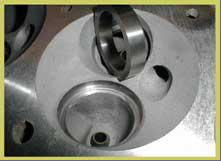
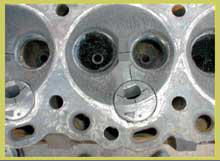
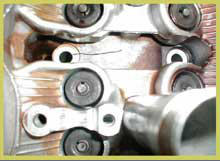
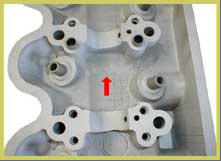
Welded crack under
valve seat
Cracked across top
of head
Crack repaired by
alloy welding
Cracked head &
combustion chambers




















•
Queensland Transport Authorised to approve LA1,LA3,LB1,LD1-2,LK1,LK6 Modification’s to light vehicles
•
LPG Approved Workshop
•
RWC Licence
•
RACQ Approved Automotive Repairer




Head engine problem Brisbane -
CRACKED
Most cylinder heads crack due to running above the temperature they were designed to operate at. Thermal shock can also be responsible for cylinder head cracks. Thermal shock occurs when the temperature of the cylinder head suffers a quick and significant change in temperature. In the case of vehicles it occurs most commonly when the operator introduces cold water to an already overheated engine. The sudden lowering of the engine temperature causes the head casting to crack where ever the head is the hottest, thinnest or weakest. This is usually around valve seats, exhaust ports and the top of the head. The quenching of the casting causes cracks to appear at these stress points. When an engine is severely overheated the cylinder head temperature rises even higher when the engine is finally shut off. This great rise in temperature will cause most cast iron heads to crack across and between valve seats. As castings are designed lighter and the exhaust and intake ports larger the modern head has decreased in its ability to withstand damage during an over-heat. It is very common for the modern alloy cylinder head to crack across the top in the tappet cover area. The engine that has a crack going to water across the top usually runs but uses water, will not recover water back to the radiator and has oil in the cooling system. A hot cooling system pressure test, combined with a look in the tappet cover area will usually confirm this damage. Cracks in alloy heads can generally be repaired successfully by engine reconditioners using a tig welder. The result of an overheated alloy head is often very serious as the casting can become soft and if repaired and reused may never hold head tension and keep blowing head gaskets. A hardness test must be part of the preliminary investigations during repairs. A visual check of the seating area of the head bolts will also indicate the hardness of the head. (the head bolt seating pad will be impressed by the head bolt) Cracked seats in cast heads can be repaired by cold stitching crack repairs and fitting machined valve seat inserts. All head repairs should have a pressure test to determine the success of the crack repairs and the detection of hidden cracks. Foreign material inducted into the combustion chamber is a more obvious cause of combustion chamber cracks. With this type of failure any pistons and rods that have visible damage must be removed for inspection and possible replacement. All affected con rods should have their alignment checked. Combustion chamber damage should be repaired and the head pressure tested for leaks. Alloy heads should be welded and restored to shape. Minor combustion chamber damage to a cast iron head is better off dressed up and all edges smoothed out rather than being welded. (Crack test and pressure test is essential) Disclaimer Agreement : Every care has been taken in writing this information and procedures, but no responsibility can be excepted for errors, omissions or misuse of this information and procedures. The information available on this site is for your instruction only and cannot be copied for sale, © copyright 2001 UMR Engines
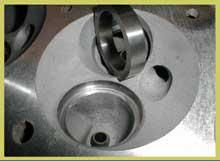


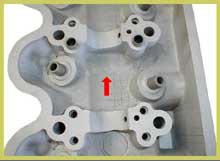
Welded crack under
valve seat
Cracked across top
of head
Crack repaired by
alloy welding
Cracked head &
combustion chambers




7 Moss Street, Slacks Creek, Qld 4127




































